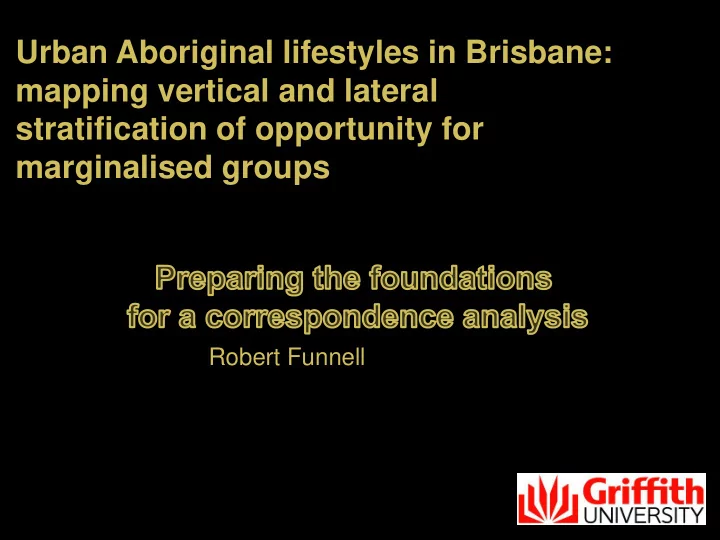

Urban Aboriginal lifestyles in Brisbane: mapping vertical and lateral stratification of opportunity for marginalised groups Robert Funnell
History of Aboriginal surveys Research question: “Given the opportunity can Aborigines be the equal of the whites in every way?” 1960s Census question • Many aborigines on reserves & all aborigines excluded from the census until 1967 • Migration to cities – measures of social (racial) distance & estimation of population (1950s & 1960s) • Social demographics & inequalities (1970s and 1980s) • Census + policy surveys (focus on Aboriginal populations)
Statistically opaque: urban Aboriginal lifestyles Phases of urban statistical research Phase 1 Phase 2 Phase 3 1950s 1960s & 70s 1980s • Segregation policy • Urban migration • Aboriginal (Protection Acts) from reserves urbanisation in • Measures of social • First surveys – spatial capital cities • Comparing household distance & demographic aspects of migration & census statistics • “Suspect classifications” • Census 1967 – • No connections made statistics linked to • Symbolic force of • Census remains as welfare policies legislative regime the sole statistical benchmark
Limitations of census & separate Aboriginal culture for understanding urbanisation Census categories and variables No disaggregation to local space
Bourdieu: urban space and lifestyles Types of capital Volume of capital
The survey: groups & lifestyles compared • Aboriginal, other residents & recent refugees • 140 lifestyle variables – e.g. demographics, use of income, dispositions to future, safety for way of life • 498 surveys – 80 refugees as supplementary • Some Aboriginal families in similar positions; others close to: aspirational Islanders, middle class whites
A “tyranny of distance”: some challenges for applying correspondence analysis: • Bourdieu’s statistics, CA, not the main game in Australia – (Hage, race, Teese education) • Which program? – SPAD, R, SPSS, Excel Stat? • Richard Volpato – “CA as a practice” – how? – no founding, second or third generation path breakers (e.g. Brigitte Le Roux, Broady and others) • If a practice; where to begin the analysis – which preliminary steps (cross-tabs of columns & modalities, relating outputs to ethnographic detail – to concepts or theory?
Directions • Interviews with individuals in different and contradictory parts of space (e.g. Mike Savage, Jan Thorhauge) • Extension of survey to other higher status groups (on key questions from this survey) • Extension of the survey into a prosography (collective biographies) of the trajectories of Aboriginal people into prominent positions (e.g. sport, cultural performance, authors, politicians, entertainers, public servants, entrepreneurs)
Recommend
More recommend